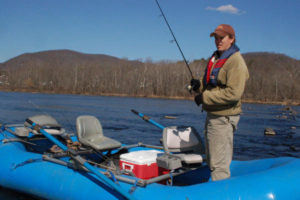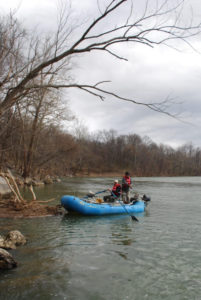Cold Water Paddling & Fishing Safety Tips from Virginia DGIF

Life Jackets are important
Always wear a life jacket when afloat.
By Bruce Ingram
from The Fishing Wire
Photos by Bruce Ingram
The most dangerous incident of my paddling career occurred on the James River when a friend and I overturned in his canoe. Earlier, my water temperature gauge had registered 54 degrees and the air temperature 65 degrees. When I fell in, I felt as if a sledge hammer had struck my chest, and my buddy and I struggled to swim to shore – losing most of our gear.
That day, the air and water temperature combined measured 119 degrees – within the danger zone says Stacey Brown, boating safety program manager for the DGIF. She adds that although many variables exist concerning when the risk of hypothermia becomes more acute, generally if the air and water temperatures together are 120 degrees or below, wet suits are recommended for paddlers. Another major factor, continues Brown, has to do with the amount of time someone is subject to the cold water and air temperatures.

Boat with a buddy in cold weather
Especially in cold water conditions, like these two anglers on the New River, please consider going floating and/or fishing with a buddy.
Obviously, one of the most basic acts any paddler can accomplish is to always wear a life jacket. But in my many decades of floating and wade fishing Virginia’s rivers and streams, I would wager that most paddlers I have observed – whatever the season from the dog days of summer to the frigid waters of winter – were not wearing life jackets. Many, in fact, did not even have them in their craft or were just using them as seat cushions.
“Wearing a life jacket is the best way to ensure your trip doesn’t end in tragedy,” emphasizes Brown. “It would be nice that people think of their life jackets as gear, just like with other sports, rather than required equipment.”
Brown offers the following additional recommendations.
*Carry your whistle or other sound producing device in case you do need to summon help.
*Be proficient in re-boarding your canoe, kayak, raft or other craft – especially if you are in a lake or larger river where getting to the shore to re-board would be difficult. If you end up in the cold water – you start to loss dexterity of movement fairly quickly.
*Paddle with a buddy – not only for more fun – but just in case of emergency.
*Evenly pack your boat to have an even keel (so to speak) – and help mitigate the chances of overturning.
*Let someone on dry land know where you are going and when you plan to return – in other words, share your float plan.
*Check the weather before and during the trip. During the excursion, be aware of changing or increasing winds and/or cloud build up.
*Be honest about your skills – know your limitations. For example, planning a long trip of many miles or hours during unfavorable water temperatures or forecasts could be risky for many floaters.
In the angling realm, there’s nothing I would rather do than float and fish the Old Dominion’s many outstanding rivers, but I know that my continuing to enjoy this pastime involves making wise decisions. Please consider making these safety tips part of your game plan.